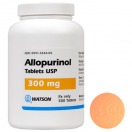ALLOPURINOL
THERAPEUTIC ACTIONS
This drug acts by inhibiting the enzyme responsible for the conversion of purines to uric acid, thus reducing the production of uric acid with a decrease in serum and sometimes in urinary uric acid levels, relieving the signs and symptoms of gout.
INDICATIONS
1. Management of the signs and symptoms of primary and secondary gout;
2. Management of patients with malignancies that result in elevations of serum and urinary uric acid; and of patients with recurrent calcium oxalate calculi whose daily uric acid excretion exceeds 800 mg/day (males) or 750 mg/day (females); and
3. Orphan drug use: Treatment of Chagas' disease; cutaneous and visceral leishmaniasis
CONTRAINDICATIONS
This drug is contraindicated with patients who are allergic or hypersensitivity to allopurinol, and has blood dyscrasias. Use cautiously with patients with liver disease, renal failure, and women who are pregnant or lactating.
ADVERSE EFFECTS
CNS: Headache, drowsiness, peripheral neuropathy, neuritis, paresthesias
Dermatologic: Rashes—maculopapular, scaly or exfoliative—sometimes fatal
GI: Nausea, vomiting, diarrhea, abdominal pain, gastritis, hepatomegaly, hyperbilirubinemia, cholestatic jaundice
GU: Exacerbation of gout and renal calculi, renal failure
Hematologic: Anemia, leukopenia, agranulocytosis, thrombocytopenia, aplastic anemia, bone marrow depression
INTERACTIONS
Drug-drug
1. Increased risk of hypersensitivity reaction with ACE inhibitors;
2. Increased toxicity with thiazide diuretics;
3. Increased risk of rash with ampicillin;
4. Increased risk of bone marrow suppression with cyclophosphamide, other cytotoxic agents; 5. Increased half-life of oral anticoagulants;
6. Increased serum levels of theophylline; and
7. Increased risk of toxic effects with thiopurines, 6-MP (azathioprine dose and dose of 6-MP should be reduced to one-third to one-fourth the usual dose)
NURSING CONSIDERATIONS
Assessment
History: Allergy to allopurinol, blood dyscrasias, liver disease, renal failure, lactation
Physical: Skin lesions, color; orientation, reflexes; liver evaluation, normal urinary output; normal output; CBC, LFTs, renal function tests, urinalysis
Interventions
1. Administer drug after meals;
2. Promote increased fluid intake from 2.5 to 3 L/day to decrease the risk of renal stone development;
3. Check urine alkalinity - urates crystallize in acid urine; sodium bicarbonate or potassium citrate may be ordered to alkalinize urine; and
4. Discontinue drug at first sign of skin rash; severe to fatal skin reactions have occurred.
Teaching points
1. Instruct patient to take the drug after meals;
2. Avoid over-the-counter medications. Many of these preparations contain vitamin C or other agents that might increase the likelihood of kidney stone formation. If you need an over-the-counter preparation, check with your health care provider;
3. Educate patient that he may experience these side effects: Exacerbation of gouty attack or renal stones (drink plenty —2.5–3 L/day—of fluids while on this drug); nausea, vomiting, loss of appetite (take after meals or eat frequent small meals); drowsiness (use caution while driving or performing hazardous tasks); and
4. Encourage patient to report unusual bleeding or bruising; fever, chills; gout attack; numbness or tingling; flank pain, skin rash.
REFERENCES:
Allopurinol Image. http://www.vetpetmed.com/images/ALLOPURINOL_300mg.jpg
Karch, Amy M. Lippincott Williams & Wilkins. 2007 Nursing Drug Guide.
HOME | A-B | C-D | E-F | G-H | I-J | K-L | M-N | O-P | Q-R | S-T | U-V | W-X | Y-Z | HOME
This is a free website hosted by weebly.
This is created for Student Nurses by blue_identity.

